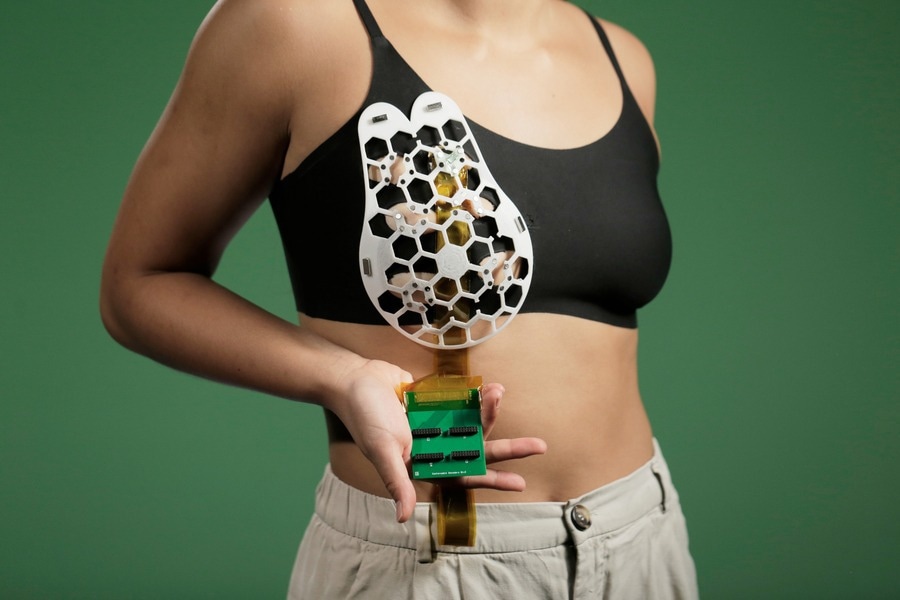Each year around 2.3 million people are diagnosed with breast cancer, and while survival rates have drastically improved in recent decades, early diagnosis is key to ensuring breast cancer patients receive the treatment they need.1

Image Credit: Canan Dagdeviren, MIT
These figures have prompted a team of researchers at MIT to design a wearable ultrasound device that could further improve the chances of survival for breast cancer patients. The device uses ultrasound technology that could be incorporated into a bra to allow more frequent monitoring of high-risk patients between routine mammograms.
Published in the journal Science Advances, the team describes how the device can capture ultrasound images with resolutions of relative comparability to those acquired using ultrasound probes typically used in medical centers and hospitals.
This technology provides a fundamental capability in the detection and early diagnosis of breast cancer, which is key to a positive outcome.
Professor Anantha Chandrakasan, Dean of MIT’s School of Engineering, and the Vannevar Bush Professor of Electrical Engineering and Computer Science
Revolutionizing Wearables
Modern wearable devices are changing the game regarding how we think about our personal health, as smartwatches and fitness trackers allow users to access real-time health data, which can influence lifestyle choices and improve quality of life.
Yet, while today wearable technology is increasingly becoming associated with fashion and lifestyle accessories, the medical industry has been putting wearable to use since the 1980s when the first wireless ECG (electrocardiogram) was invented.2
Wearable medical devices offer patients convenient and easy health monitoring for various conditions, such as heart health, blood pressure, sleep regularity, and general fitness. Healthcare professionals can then interpret the data collected to make an early diagnosis or fine-tune any treatment in real-time in line with the patient’s needs.
The increased popularity of wearable technology, coupled with the convenience it offers patients, is once again revolutionizing the way we approach personal healthcare, and the flexible patch device the MIT team has created could prove invaluable when it comes to diagnosing and treating one of the most common cancers.
We changed the form factor of the ultrasound technology so that it can be used in your home. It’s portable and easy to use, and provides real-time, user-friendly monitoring of breast tissue.
Canan Dagdeviren, Associate Professor, Media Lab, MIT
The Pursuit of Improved Diagnostics
Inspired by her late aunt’s experience with breast cancer, Dagdeviren conceptualized a device that could be worn by incorporating a flexible ultrasound patch into a bra to maintain frequent screening of patients between scheduled mammograms.
Known as interval cancers, tumors that develop between routine screenings account for around 20-30% of breast cancer cases and can be much more aggressive than tumors detected early during a routine mammogram.
Dagdeviren’s aunt was one of those patients at high risk and was diagnosed with late-stage breast cancer despite regular screenings. In an attempt to prevent such cases from recurring, Dagdeviren designed a miniature ultrasound scanner that allows the user to conduct imaging at the touch of a button.
My goal is to target the people who are most likely to develop interval cancer… With more frequent screening, our goal to increase the survival rate to up to 98 percent.
Canan Dagdeviren, Associate Professor, Media Lab, MIT
To make the miniature ultrasound scanner wearable, the team used innovative piezoelectric materials and 3D printing to create a device with a honeycomb configuration to make it more flexible. The device can be attached to the inside of a bra using magnets, bringing it into contact with the wearer’s skin to facilitate ultrasound scanning.
Moreover, the device can easily be moved around to scan the entire breast from a variety of angles without the need for any user training. However, more work is needed to improve the technology, as seeing the ultrasound images the device collects still requires a connection to the type of machine found in on-site imaging centers.
The team will now focus on miniaturizing the imaging system by designing a portable device about the size of a smartphone that would further mobilize the system away from on-site diagnosis.
One of the main obstacles in imaging and early detection is the commute that the women have to make to an imaging center. This conformable ultrasound patch is a highly promising technology as it eliminates the need for women to travel to an imaging center.
Tolga Ozmen, Breast Cancer Surgeon, Massachusetts General Hospital
The researchers will also work to enhance the workflow, incorporating artificial intelligence for real-time analysis of the images as well as exploring the potential for modifying the ultrasound technology so that it can be used for other parts of the body to detect other types of cancer and illness.
References and Further Reading
- Breast cancer (2023) World Health Organization. Available at: https://www.who.int/news-room/fact-sheets/detail/breast-cancer#:~:text=Scope%20of%20the%20problem,the%20world’s%20most%20prevalent%20cancer.
- Salam, A. (2019) ‘The invention of Electrocardiography Machine’, Heart Views, 20(4), p. 181. Available at: https://www.ncbi.nlm.nih.gov/pmc/articles/PMC6881865/.
- Du, W. et al. (2023) ‘Conformable ultrasound breast patch for deep tissue scanning and imaging,’ Science Advances, 9(30). Available at: https://www.science.org/doi/10.1126/sciadv.adh5325.
- Trafton, A. (2023) A wearable ultrasound scanner could detect breast cancer earlier, MIT News | Massachusetts Institute of Technology. Available at: https://news.mit.edu/2023/wearable-ultrasound-scanner-breast-cancer-0728
Disclaimer: The views expressed here are those of the author expressed in their private capacity and do not necessarily represent the views of AZoM.com Limited T/A AZoNetwork the owner and operator of this website. This disclaimer forms part of the Terms and conditions of use of this website.